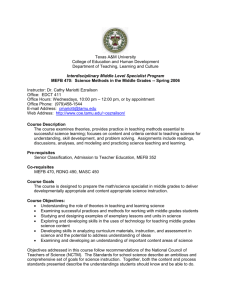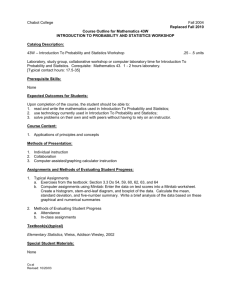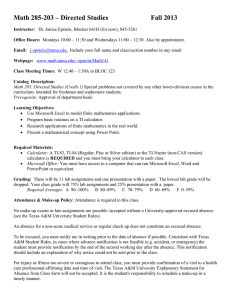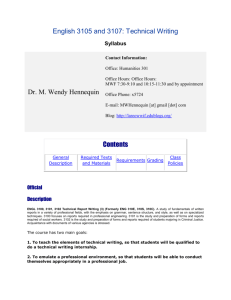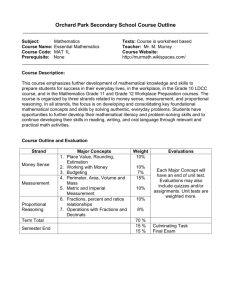© Scarborough Math 366 ... 1
advertisement
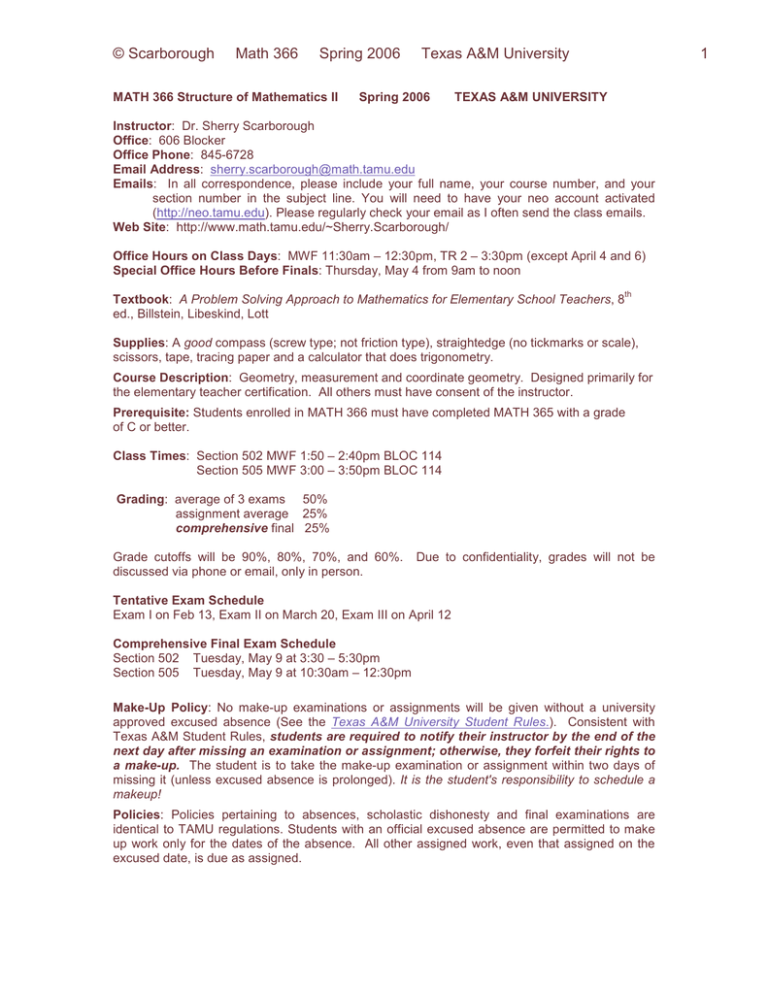
© Scarborough Math 366 Spring 2006 MATH 366 Structure of Mathematics II Texas A&M University Spring 2006 1 TEXAS A&M UNIVERSITY Instructor: Dr. Sherry Scarborough Office: 606 Blocker Office Phone: 845-6728 Email Address: sherry.scarborough@math.tamu.edu Emails: In all correspondence, please include your full name, your course number, and your section number in the subject line. You will need to have your neo account activated (http://neo.tamu.edu). Please regularly check your email as I often send the class emails. Web Site: http://www.math.tamu.edu/~Sherry.Scarborough/ Office Hours on Class Days: MWF 11:30am – 12:30pm, TR 2 – 3:30pm (except April 4 and 6) Special Office Hours Before Finals: Thursday, May 4 from 9am to noon th Textbook: A Problem Solving Approach to Mathematics for Elementary School Teachers, 8 ed., Billstein, Libeskind, Lott Supplies: A good compass (screw type; not friction type), straightedge (no tickmarks or scale), scissors, tape, tracing paper and a calculator that does trigonometry. Course Description: Geometry, measurement and coordinate geometry. Designed primarily for the elementary teacher certification. All others must have consent of the instructor. Prerequisite: Students enrolled in MATH 366 must have completed MATH 365 with a grade of C or better. Class Times: Section 502 MWF 1:50 – 2:40pm BLOC 114 Section 505 MWF 3:00 – 3:50pm BLOC 114 Grading: average of 3 exams 50% assignment average 25% comprehensive final 25% Grade cutoffs will be 90%, 80%, 70%, and 60%. discussed via phone or email, only in person. Due to confidentiality, grades will not be Tentative Exam Schedule Exam I on Feb 13, Exam II on March 20, Exam III on April 12 Comprehensive Final Exam Schedule Section 502 Tuesday, May 9 at 3:30 – 5:30pm Section 505 Tuesday, May 9 at 10:30am – 12:30pm Make-Up Policy: No make-up examinations or assignments will be given without a university approved excused absence (See the Texas A&M University Student Rules.). Consistent with Texas A&M Student Rules, students are required to notify their instructor by the end of the next day after missing an examination or assignment; otherwise, they forfeit their rights to a make-up. The student is to take the make-up examination or assignment within two days of missing it (unless excused absence is prolonged). It is the student's responsibility to schedule a makeup! Policies: Policies pertaining to absences, scholastic dishonesty and final examinations are identical to TAMU regulations. Students with an official excused absence are permitted to make up work only for the dates of the absence. All other assigned work, even that assigned on the excused date, is due as assigned. © Scarborough Math 366 Spring 2006 Texas A&M University Grade Disputes: Once you leave class with your graded examination or assignment you accept its grade. All grade disputes must be dealt with at the time you receive the examination or assignment. Assignments: There will be problem-solving assignments throughout the semester. These assignments may be designed as in-class or out-of-class individual- or group-work. All out-ofclass assignments are due at the beginning of class on the date due, unless otherwise instructed. In-class assignments may be given and taken up at any time during class. Three of the lowest assignment scores will be dropped before the assignment average is computed at the end of the semester, though certain assignments will not qualify to be dropped regardless of the grade. Doing “Now Try This,” Brainteasers,” “Ongoing Assessment,” “Laboratory Activity,” “Questions From The Classroom,” and “Chapter Review” problems will help you with your learning and your assignments. Attendance: Attendance is required. Math 366 is a mathematics content course for students working towards certification to teach elementary school. This course is not a methods course to teach you specific strategies for teaching mathematics to children. However, Math 366 does engage you in experiences that strengthen your understanding of the concepts and underpinnings important to the mathematics taught in Kindergarten - Grade 8 so that you can make effective instructional decisions and generate appropriate questions when teaching mathematics. You will be expected to participate in several in-class activities that lead to discussions of concepts and language that you will see again on the major exams. It is essentially impossible to replicate these experiences outside of the class environment; therefore, class attendance and participation are extremely important. Plagiarism: All printed handouts and web materials are protected by US Copyright Laws. Handouts are all materials generated for this course, which include but are not limited to syllabi, assignments, examinations, in-class materials, and anything downloaded from a web page. Because these materials are copyrighted, you do not have the right to copy the handouts, unless I expressly grant permission. Academic Integrity Statement: "An Aggie does not lie, cheat, or steal or tolerate those who do." The Honor Council Rules and Procedures are on the web at http://www.tamu.edu/aggiehonor. Students may work together on their homework from the text, unless otherwise directed, but are expected to turn in their own work. Examinations and all assignments are to be taken individually. As commonly defined, plagiarism consists of passing off as one's own the ideas, words, writings, etc., which belong to another. In accordance with this definition, you are committing plagiarism if you copy the work of another person and turn it in as your own, even if you should have the permission of that person. Plagiarism is one of the worst academic sins, for the plagiarist destroys the trust among colleagues without which research cannot be safely communicated. Disabilities: The Americans with Disabilities Act (ADA) is a federal anti-discrimination statute that provides comprehensive civil rights protection for persons with disabilities. Among other things, this legislation requires that all students with disabilities be guaranteed a learning environment that provides for reasonable accommodation of their disabilities. If you believe you have a disability requiring an accommodation, please contact the Department of Student Life, Services for Students with Disabilities, in Room 126 of the Koldus Building or call 845-1637. Personal Requests: You are always welcome to come to my office hours; you do not need an appointment. I encourage you to come, ask questions, as often as you would like. Students who come to office hours can get personal attention and help. If you smoke, please ‘air out’ before visiting. As a courtesy to all, please turn your cell phones and pagers off during all classes and during office hours. Thanks! Emergencies: On-campus phones Off-campus and cell phones 9-911 911 2 © Scarborough Math 366 Spring 2006 Texas A&M University Please note: It is extremely important that you move beyond “the rules of mathematics,” investigate why they work, and what other strategies can be employed. Many times you will develop “the rules” and “the formulas.” It is necessary to know why, as well as the how, of the mathematics involved in this course. You are expected to learn the concepts and the behind-thescenes workings. While it is critical that you attain the correct answer to a question, you must show correctly, precisely, and accurately its solution (all the steps, labels, explanations, equal signs, models, etc.) in an orderly, clear, concise manner. Where appropriate circle your final answer. Give exact answers, unless otherwise stated (estimations or approximations). Please bring your text to class. You are responsible for your own learning. This class has high standards since some of you will be teaching our children and our grandchildren. Spelling counts, especially on exams. TENTATIVE SCHEDULE Jan 18 – 23 Week 1: Introduction, Sections 9.1 – 9.2 Jan 25 – 30 Week 2: Sections 9.2 – 9.4 Feb 1 – 6 Week 3: Sections 9.4 – 9.5 Feb 8 – 13 Week 4: Section 10.1, Review, Exam I (on Chapter 9) Feb 15 – 20 Week 5: Sections 10.1 – 10.2 Feb 22 – 27 Week 6: Sections 10.3 – 10.5 March 1 – 6 Week 7: Sections 10.5 – 11.1 March 8 – 20 Week 8: Section 11.1, Review, Exam II (on Chapter 10) March 22 – 27 Week 9: Sections 11.2 – 11.3 March 29 – April 3 Week 10: Sections 11.4 – 11.5 April 5 – 10 Week 11: Sections 11.5 – 12.1, Review April 12 – 19 Week 12: Exam III (on Chapter 11), Sections 12.1 – 12.3 April 21 – 26 Week 13: Sections 12.3 – 12.4 April 28 – May 2 Week 14: Sections 12.5, Review 3 © Scarborough Math 366 Spring 2006 Texas A&M University Homework Note: There is a protractor on text page 504. Definitions and properties of quadrilaterals are on pages 579 – 580. The last three pages of your chapter 12 notes contain a dot grid, a [–10, 10] by [–10, 10] coordinate plane, and a grid of squares for your use in doing homework. Section 9.1 9.2 9.3 9.4 9.5 10.1 10.2 10.3 10.4 10.5 10.6 Problems # 1,2, 4-7, 8 (trace angle with tracing paper, then use protractor on page 504), 9, 1217, 19, 22, 23 # 1-13, 16-18 # 1-20, 22-25, 27-32, 37 # 1-11, 13, 14, 16-18, 20, 21, 23, 25, 30-34 # 1, 3-10, 13, 14 # 1-7, 9-17, 19-23, 25-28, 30, 31, 33 # 2-7, 9-12, 14-20, 22-24, 30-33 # 3-8, 10-19, 21, 22, 29, 30 # 1-14, 16, 19, 20, 24-26, 30, 31 # 1-4, 9, 14 (On all problems, give the exact answers in terms of the trig functions themselves, and then use a calculator to find the approximate answer to the nearest hundredth.) # 1-12, 15, 17, 19, 34, 35 Chapter 11 Before you start chapter 11, read the “Math 366 Study Guide” found on my web page. 11.1 11.2 11.3 11.4 11.5 # 1, 3, 4, 7-11, 14, 16, 18, 20-23, 26-29, 31 # 2, 4, 5-7, 9-29, 32-35, 37, 47 # 1, 2, 4, 5, 7-13, 15, 23-27, 32-37, 39, 40, 43, 45-47 # 1-15, 18a, 18b, 19, 20, 23, 24, 30-33 # 1-7, 9-16, 20, 22, 24, 25, 27-29, 32, 36-38, 40-42, 44, 52-55 12.1 12.2 12.3 12.4 12.5 # 1-8, 11, 13, 17, 18, 21, 24, 25 # 1, 4, 5, 9-11, 13, 14, 26-29 # 1-4, 6-9, 11, 17, 18 # 2-13b # 1-6, 8, 11, 12 4
